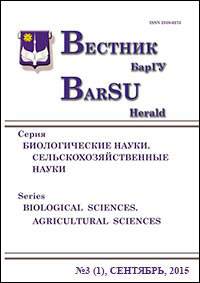YIELD AND SEED EFFICIENCY OF SPRING WHEAT AND SPRING BARLEYDEPENDING ON CULTIVATION TECHNOLOGY TECHNIQUES
Keywords:
spring wheat, spring barley, yield, seed yield, sowing rates, fertilizer ratesAbstract
The results of three-year research on the study of the effect of seed specific weight, chemical means of plant protection, sowing rates and nitrogen fertilizer rates on seed yield and efficiency of spring wheat and barley are presented in the
article. It was defined that the use of two fungicidal treatments in the period of vegetation (the first treatment — at the flag leaf stage, the second one — at the stage of heading) increased grain yields of spring wheat and spring barley by 0.2 t / ha and 0.39 t / ha, respectively. The use of seeds with low specific weight for sowing decreased the grain yields of spring wheat and barley by 0.23—0.4 and 0.3—0.34 t / ha, respectively. The use of split nitrogen fertilizing in the rate of N60+60 and the sowing rates equaled to 3.5 million viable seeds per hectare for spring barley and 4.5 million for spring wheat made it
possible to obtain additionally up to 0.57 and 0.27 t / ha of seeds, respectively. At the cultivation of spring barley and spring wheat, calculated additional revenues were 2 445.3 and 1 354.2 million roubles per hectare, respectively.
Table 8. Ref.: 5 titles.
Downloads
Published
Issue
Section
License
Copyright (c) 2023 Вестник БарГУ Серия "Биологические науки. Сельскохозяйственные науки"
Это произведение доступно по лицензии Creative Commons «Attribution-NonCommercial» («Атрибуция — Некоммерческое использование») 4.0 Всемирная.
Авторы сохраняют за собой право заключать определенные договорные соглашения, касающиеся неисключительного распространения опубликованной версии работы (например, размещать ее в институциональном репозитории, публикация в книге) со ссылкой на ее первоначальную публикацию в этом журнале.





